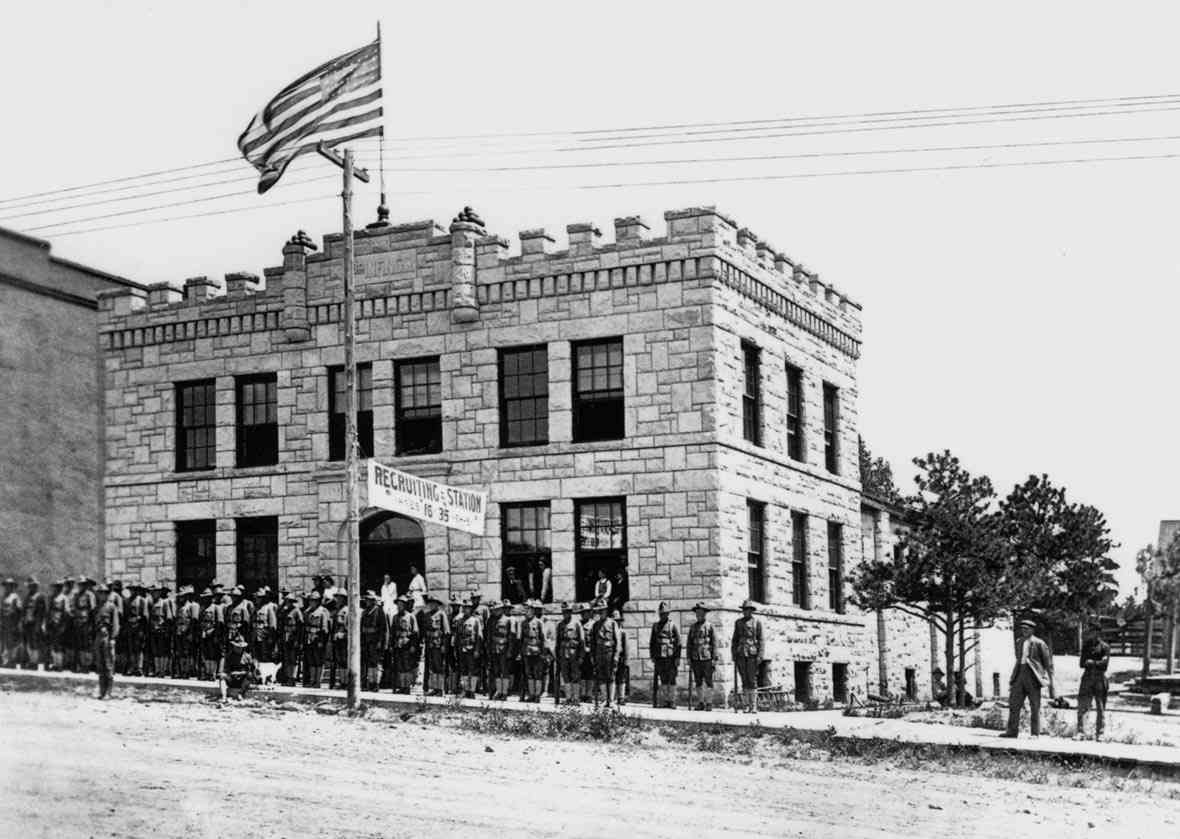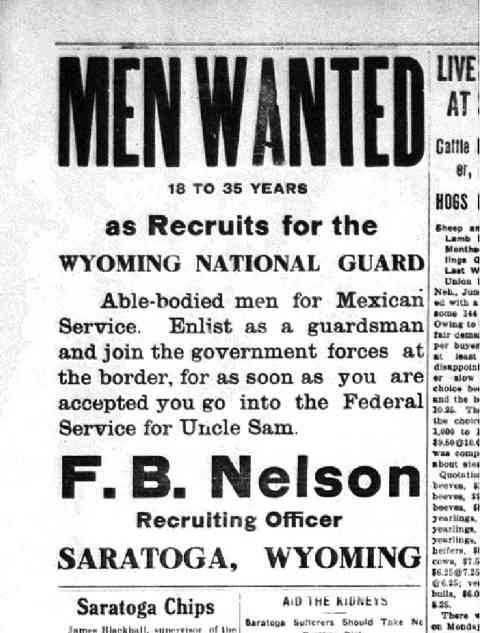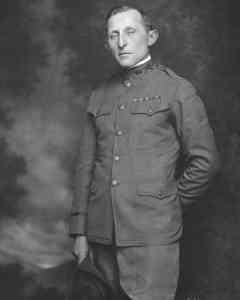- Home
- Encyclopedia
- The Wyoming Guard On The Mexican Border, 1916
The Wyoming Guard on the Mexican Border, 1916
On June 18, 1916, nearly two months after General John J. “Black Jack” Pershing led U.S. troops across the Mexican border to pursue the revolutionary leader Pancho Villa, President Woodrow Wilson mobilized the National Guard for border duty to prevent further incursions by Villa and other Mexican revolutionaries.
The Villa forces’ raid on Columbus, N. Mex. in March 1916 had been the final provocation that led to U.S. pursuit. The raid had followed many months of previous skirmishes with Villa’s and other forces, raiding north out of the turmoil of the Mexican Revolution.

The president’s proclamation thrilled the nation. Not since the Spanish-American War had there been such a heightened feeling of patriotism. The people of Wyoming, at least initially, seemed determined to do their part.
Like other National Guard troops deployed to the border, the Wyoming soldiers eventually would spend many months in training camps but see no action. Still, many of these same men would find the military experience useful the following year, when the U.S. joined the Allies in the war against Germany and Austria, and Wyoming soldiers found themselves in combat in France.
After Wilson’s announcement in the spring of 1916, Wyoming newspaper editors urged readers to do their civic duty and volunteer for what was seen as a noble and heroic endeavor. Rosters of National Guard company members and individual enlistees were published to encourage more men to sign up.
The Union Pacific Railroad, the Colorado and Southern Railroad and Mountain States Telephone & Telegraph Company granted leave to guardsmen with the promise that their jobs would be waiting for them on their return. Communities responded in kind with parades, banquets, entertainment, patriotic religious services and parting gifts.
Wyoming Adjutant Gen. Rasmus Anderson promised to supply two battalions consisting of eight of the state’s nine National Guard companies to the border. To do this, it was imperative to mobilize the existing companies and recruit men to get the companies up to war strength as soon possible. Subsequently, Anderson instructed local and guard officials to “rush recruiting so that we may mobilize quickly. Wyoming must not be behind in getting into service.”
At around 75 officers and enlisted men per company, the eight companies Anderson promised would have meant 600 Wyoming men deployed to the border. There they joined 140,000 other guard soldiers from around the nation.
Federal authority over state militias had been ambiguous since 1792. In 1903, in the wake of the Spanish American War, Congress passed the Dick Act, which standardized training and equipment among the militias, supplied federal funds and organized them under federal authority, and the term “National Guard,” though not yet required, came into general use. In 1908, Congress authorized use of the Guard outside U.S. borders. In June 1916, Congress further increased federal authority over the Guard by mandating that Guard troops be taken directly into federal service when they were to be sent out of the nation. Wilson called up the Guard units and sent them to New Mexico within a matter of days.
War Department regulations required enlistees to be between the ages of 18 and 65. Boys 16- and 17-years old needed their parents’ consent. Wyoming Gov. John B. Kendrick urged men with dependent families to stay at home.
Ready to serve, mostly
Despite these limitations, young boys and old men announced their willingness to serve their country. Though these two age groups were banned from military service, newspapers recounted poignant stories in the hope that men more suitable for military service would enlist.

For example, there was an unidentified 8-year old boy who was determined to do his part. Cheyenne’s 16-year old Frank Highleyman claimed to be the youngest recruit, only after he had secured, with some persuasion, his parents’ consent. P.C. Stepp, an old Indian fighter in the Wind River Valley, knew he was too old for the Wyoming National Guard, so he planned to enlist in Missouri where his son was in the guard.
But there were some genuine offers. Andrew George, a Greek-American, was “ready to stand up for Uncle Sam.” Some men proposed organizing volunteer companies. Movie star and prominent rancher Tim McCoy and future governor Robert Carey reportedly planned to organize a Wyoming cowboy cavalry. Ministers wanted to serve as chaplains. To encourage enlistment from southwest Wyoming, Gov. Kendrick told Mormon bishop H.M. Rollins of Lyman “I am ambitious to have one of our best companies known as a strictly Mormon company.”
George M. Sliney, a veteran of the frontier Army who had retired from his position as Wyoming Adjutant General in February 1916, wanted to serve despite his age. “I do not relish,” he wrote the new adjutant general, “being side tracked during the last two months of a life time service. Someone may remark that age interferes with my efficiency, [to which] I reply by stating that Colonel Dodd, now in command of Pershing’s Cavalry[,] is older than I am. I think it is my just dues considering my services to the State and Nation, that I be allowed this opportunity.” Out of respect, Gen. Anderson reinstated him, but Sliney retired with rank of colonel a final time in August 1916 before the Wyoming guardsmen received their marching orders.
But not everyone was filled with patriotism. Boyd T. Dickinson, a meat market employee in Powell, insulted the local guard company by stating, “Anybody who will wear a uniform is a pinhead.” Guardsmen and members of the local community did not take his comment lightly. Dickinson was promptly forced to apologize to the guardsmen and the general public, to express respect for the flag and to acknowledge respect for the men “who stand ready to fight for it.”
A couple of newspaper editors criticized the newfound war spirit sweeping the country. E.S. Drury of The Wheatland Times wondered in his columns why, if Wyoming’s Congressman Frank Mondell was so supportive of the war, he didn’t enlist. Drury wrote, “He didn’t want to fight–he wanted you to do it.”
H.J. Wendt, publisher and editor of The Wind River Mountaineer found war to be a less than noble enterprise. He explained, “Let us be calm and considered; not rash and impulsive. Let us wait with patience, and not rush too eagerly into the fray.” But his and Drury’s views were in the minority.
Mobilization difficulties
When it came time to mobilize, the Wyoming National Guard encountered problems. Many guardsmen were found to be physically unfit and were summarily dismissed. Men with families to support, who had enlisted despite Gov. Kendrick’s request for them to remain at home, were also released. In addition, wives and mothers petitioned the governor to release their respective husbands or sons from service because they felt they were needed at home or were still in school. Many men listed on the company rosters failed to show up when called, and were declared deserters.

Before these troops could be sent to the border, the Wyoming National Guard needed enough men to bring its military units to war strength, but despite all the enthusiasm, recruiting proved to be difficult. Enlistments were slow in many places. Individuals and public officials claimed that recruiters were inducting underage boys into the service in order to meet their quotas. Frustrated, and worried that outsiders might questions the loyalty of the Wyoming populace, recruiters and officials tried to appeal to patriotic spirit, citing loyalty, personal sense of duty and the benefits of military training, as best as they could. By late June 1916, most companies were ready.
Training
Initially, officials hoped to send guardsmen to Fort D.A. Russell near Cheyenne, Wyo., for further training, but the War Department denied the use of the fort or its grounds for that purpose. Gov. Kendrick and military officials quickly designated an alternative site near Frontier Park on open rangeland north of the city. A makeshift camp was established and named Camp Kendrick.
The purpose of Camp Kendrick was to give intensive military training to guardsmen prior to their deployment along the border. Military life quickly settled into long days of training and to some, drudgery and boredom. A short-lived quarantine during a smallpox outbreak further magnified their isolated state.
Athletic and musical events provided some respite. Men looked forward to leaving the camp and going into Cheyenne, but there were some limitations. The red-light district was off limits. Military provosts patrolled downtown to make sure guardsmen behaved properly and returned to camp on time. Nonetheless, some men found ways to get into trouble, including leaving camp without permission, becoming drunk and causing public disturbances. Some were arrested: infractions ranged from murder and bigamy to theft. G.S. Dilley of Laramie left for the city and was never seen again. Officials were unable to determine if he was murdered or had just deserted.
Desertion was a major problem. Two friends, L.E. Sutton and Samuel W. Rose, had the courtesy to inform their commanding officer that they were going to desert, because they did not like military life at Camp Kendrick. Most who deserted simply left.
While some troops may have despised the seemingly endless routine, officials considered the training at Camp Kendrick essential to prepare guardsmen for the trials awaiting them at the border. By the late summer, many officers saw improvements in appearance and efficiency. The Wyoming National Guard was a source of pride for the state.
Deployed to New Mexico
Throughout the summer, guardsmen had been eager for deployment. Finally, on Sept. 28, 1916, the Wyoming National Guard received its orders and troops entrained for San Antonio. While en route, their orders were changed and they were sent to Deming, N.M., northwest of El Paso about 25 miles from the border, where they arrived on Sept. 30, 1916. They were billeted in a camp outside of town with regiments from Colorado, Arkansas and Delaware.
Life in Deming soon settled into more routine training and military exercises. As they had at Camp Kendrick, some men found this monotonous, and military officials once again had to deal with drunkenness, dereliction of duty, desertion and other infractions. Several men died of disease.
On occasion, officials gave the men some reprieve by allowing leaves and organized forms of entertainment. One rifle team traveled to Jacksonville, Fla., to represent Wyoming at a national shooting competition. All the while, the guardsman expected to be sent to the border at a moment’s notice, but that never happened.
In January 1917, Gen. Pershing’s regular Army troops returned from Mexico. The border crisis was, for the most part, over. On Feb. 17, 1917, the War Department ordered all National Guard units to return home.

Home again as war clouds loom
The news was disheartening. Wyoming’s National Guard leader, Gen. Anderson, reflected that the men had entered with the expectation of seeing active duty along the border, and there was disappointment in not having been deployed. However, Anderson explained to Gov. Kendrick, “We have experienced much valuable field service training,” and he noted the men were just as fit for active duty as any other state militia. The Deming Chamber of Commerce and City Hall complimented the Wyoming guardsman for their exemplary conduct and professionalism.
The Wyoming National Guard troops left Deming on March 1, 1917. They arrived at Fort D.A. Russell in Cheyenne two days later and were mustered out on March 9, 1917. Some guardsmen had jobs waiting for them, others didn’t. Their reprieve was short, however, because in late March, National Guard units mobilized once again. This time, the war in Europe threatened, and the U.S. would soon join in shortly.
Editor’s note: Special thanks to Bill Saunders, museum assistant at the Wyoming National Guard museum, for his help on Wyoming National Guard troop strengths and unit names in the 1916 mobilization.
Resources
Primary Sources
- A.G. Belcher Collection, 11511, American Heritage Center, University of Wyoming
- Adjutant General Records, Wyoming State Archives
- Governor John B. Kendrick Records, Wyoming State Archives
- Governor Frank L. Houx Records, Wyoming State Archives
- R.S. Mentzer Collection, H62-10, Wyoming State Archives
Secondary Sources
- Harris, Charles H. III and Louis R. Sadler. The Great Call-Up: The Guard, the Border, and the Mexican Revolution. Norman, Okla.: University of Oklahoma Press, 2014.
- Hurst, James W. Pancho Villa and Black Jack Pershing: The Punitive Expedition in Mexico. Westport, Conn.: Praeger, 2008.
- “Pancho Villa Expedition.” Wikipedia. Accessed March 27, 2015 at http://en.wikipedia.org/wiki/Pancho_Villa_Expedition#cite_note-61.
- Stout, Jr., Joseph A. Villistas, Carrancistas, and the Punitive Expedition, 1915-1920. Fort Worth: Texas Christian University, 1999.
- Wyoming Military Department. “Wyoming National Guard History,” accessed March 5, 2015 at http://wyomilitary.wyo.gov/hh/wyoming-army-national-guard-history.
Illustrations
- The photo of the Wyoming National Guard at the armory in Newcastle and the image of the newspaper recruiting ad are from the Wyoming State Archives. Used with permission and thanks.
- The photos of Adjutant General Anderson and of the troops mobilized for the Mexican border are from a Facebook page maintained by the Wyoming National Guard; Go to “1916” on the timeline near the bottom of the page to find the photos. Used with thanks to the Guard and to John Goss of the Wyoming Veterans Memorial Museum.
